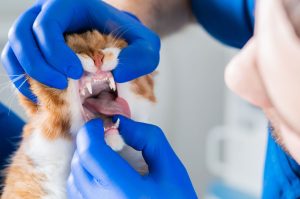Prevalence and risk factors for gingivitis in a cohort of UK companion cats aged up to 6 years
Prevalence and risk factors for gingivitis in a cohort of UK companion cats aged up to 6 years

Open access
In our edition of: Aug 2024
In our categories of: small animals
our summary:
Williams, J.L. et al (2024) Prevalence and risk factors for gingivitis in a cohort of UK companion cats aged up to 6 years. Journal of Small Animal Practice, 65 (8), pp. 605-614.
The aim of this study was to estimate the prevalence of gingivitis in a cohort of companion cats aged up to six years and to investigate risk factors for gingivitis in cats aged 3-4 years.
Data for the study were obtained from The Bristol Cats Study, a longitudinal study of a cohort of companion cats, and included owner-completed questionnaires and oral health (OH) scores completed by veterinary surgeons. The OH scorecard graded the severity of periodontal disease, based on most severe pathology present, on a five-point scale. Gingivitis was defined as an OH grade of one or above.
Cats up to 6 years of age with a completed OH card were included in the prevalence figures which were calculated for each age group (<1 year, 1 < 2 years, 2 < 3 years, 3 < 4 years, 4 < 5 years, and 5 < 6 years) using all available OH grades. Additionally, prevalence of gingivitis for a sub-group of 85 cats was calculated where three consecutive OH cards, at 1 < 2 years, 2 < 3 years and 3 < 4 years, were available to demonstrate the change of OH grades over time.
For the risk factor analysis cats were included where there was a completed owner questionnaire at 2.5 years of age available and an OH card was available at age 3-4 years.
There were 1,534 OH cards for 860 different cats included in the prevalence analysis. Prevalence ranged from 24.5% in cats less than 12 months old to 56.3% in cats aged between 5 and 6 years of age. Prevalence of gingivitis increased with increasing age.
A total of 317 cats were included in the risk factor analysis. Cases (gingivitis) made up 46% (146/317) and non-cases (no gingivitis) 54% (171/317). Odds of gingivitis in cats aged 3 to 4 years were higher in cats fed a wet or mixed wet/dry diet compared to dry only, in cats whose owners reported that they did not hunt compared to those who were reported to hunt, in cats whose owners reported that they dribbled when stroked at the age of 6 months compared to those who were reported not to dribble, and in cats with an orange colour variant in their coat compared to cats that did not have an orange coat colour variant.
Limitations of the study include the relatively small sample size for the risk factor analysis, possible variation in interpretation and application of the OH scoring criteria due to the varied experience of the veterinary surgeons completing the scorecards and potential bias in that the highly motivated owners who are taking part in The Bristol Cat Study may not be representative of the wider population of cat owners.
The study provides some evidence that will assist veterinary surgeons identify cats that may be of greater risk of gingivitis and adds to the available evidence base from which dietary and oral healthcare recommendations are made.
Reference
Murray, J.K. et al (2017) Cohort Profile: The ‘Bristol Cats Study’ (BCS) – a birth cohort of kittens owned by UK households, International Journal of Epidemiology, 46 (6), pp. 1749-1750e. https://doi.org/10.1093/ije/dyx066
The following may also be of interest:
Niemiec, B., et al. (2020) World Small Animal Veterinary Association Global Dental Guidelines. Journal of Small Animal Practice, 61 (7), pp. E36-E161. https://doi.org/10.1111/jsap.13132
Guidelines: Dental [WSAVA] [online] Available from: https://wsava.org/global-guidelines/dental-guidelines/ [Accessed 19 August 2024]
O’Neill, D.G et al. (2023) Periodontal disease in cats under primary veterinary care in the UK: frequency and risk factors. Journal of Feline Medicine and Surgery, 25 (3). https://doi.org/10.1177/1098612X231158154
Claiming CPD for reading inFOCUS articles
Reading and reflecting on articles can count towards your CPD, and we have a template to help you with the process.
Image copyright attribute: andreyzaretsky / 123RF Stock Photo




Leave a Reply
Want to join the discussion?Feel free to contribute!